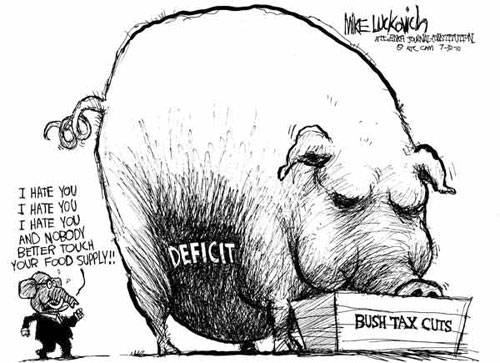By using a simple 16 year plan it can happen.
16 years of hardship but in the end America and the world would be better off and if the US retained its AAA at the end of this the US dollar would stay the world currency forever.
In my plan you could get rid of the deficit in 16 years. The idea is that you increase revenue by $1 trillion which would be a huge piece but could be done. and then you would have to reduce the spending by $1 trillion... this would roughly allow for $1 trillion dollar payments to the debt.
Zero debt
Now the wow factor is that when the GDP increases the tax base increases and the government earns more.
The cuts stay the same..... but the revenue becomes easier and easier each year.
The cuts stay the same..... but the revenue becomes easier and easier each year.
Or you can make it 30 years.
Now if you reduce spending to a more realistic $500 billion each year and increase revenue by $500 billion then the plan is extended from 16 years to probably 30 years.But it will make the deficit zero. Will allow for a AAA credit rating and as the GDP increases the revenue will be easier and easier to accomplish and as it becomes easier some of the cuts could be restored.
2010 Federal Budget
The President's budget request for 2010 totals $3.55 trillion, with revenues of $2.15 trillion with a deficit of $1.42 trillion.Mandatory spending: $2.173 trillion (+14.9%)
$695 billion (+4.9%) – Social Security
$571 billion (+58.6%) – Other mandatory programs
$453 billion (+6.6%) – Medicare
$290 billion (+12.0%) – Medicaid
$164 billion (+18.0%) – Interest on National Debt
US receipt and expenditure estimates for fiscal year 2010.
Discretionary spending: $1.378 trillion (+13.8%)
$663.7 billion (+12.7%) – Department of Defense (including Overseas Contingency Operations)
$78.7 billion (−1.7%) – Department of Health and Human Services
$72.5 billion (+2.8%) – Department of Transportation
$52.5 billion (+10.3%) – Department of Veterans Affairs
$51.7 billion (+40.9%) – Department of State and Other International Programs
$47.5 billion (+18.5%) – Department of Housing and Urban Development
$46.7 billion (+12.8%) – Department of Education
$42.7 billion (+1.2%) – Department of Homeland Security
$26.3 billion (−0.4%) – Department of Energy
$26.0 billion (+8.8%) – Department of Agriculture
$23.9 billion (−6.3%) – Department of Justice
$18.7 billion (+5.1%) – National Aeronautics and Space Administration
$13.8 billion (+48.4%) – Department of Commerce
$13.3 billion (+4.7%) – Department of Labor
$13.3 billion (+4.7%) – Department of the Treasury
$12.0 billion (+6.2%) – Department of the Interior
$10.5 billion (+34.6%) – Environmental Protection Agency
$9.7 billion (+10.2%) – Social Security Administration
$7.0 billion (+1.4%) – National Science Foundation
$5.1 billion (−3.8%) – Corps of Engineers
$5.0 billion (+100%-NA) – National Infrastructure Bank
$1.1 billion (+22.2%) – Corporation for National and Community Service
$0.7 billion (0.0%) – Small Business Administration
$0.6 billion (−14.3%) – General Services Administration
$0 billion (−100%-NA) – Troubled Asset Relief Program (TARP)
$0 billion (−100%-NA) – Financial stabilization efforts
$11 billion (+275%-NA) – Potential disaster costs
$19.8 billion (+3.7%) – Other Agencies
$105 billion – Other
I see additional revenue:
$333 billion bush tax cuts$20 billion farm
$36 billion oil and gas
Tax revenue from the companies listed
$15.345 billion
Total revenue increase:
$ 404 billion
I see cuts in mandatory spending:
Budget $2.173 trillion of say 15% ($325 billion) I see cuts in defence $663.7 billion of 20% ($132 billion)
Total cuts $457 billion
Military budget is:
$698.105 billionAmerica will save money by pulling out of Iraq
about $70 billion
America could withdraw from South Korea (as North Korea now has nukes it has fallen into a cold war with the west and simple deterrence will work)
about $15 billion a year
There are of course many many other areas that can be cut and not interfere with the war in afghan or even in the deterrence levels in the nuke arsenal
Should NPR funding be cut?
"In 2010, NPR revenues totaled $180 million, with the bulk of revenues coming from programming fees, grants from foundations or business entities, contributions and sponsorships. According to the 2009 financial statement, about 50% of NPR revenues come from the fees it charges member stations for programming and distribution charges. Typically, NPR member stations receive funds through on-air pledge drives, corporate underwriting, state and local governments, educational institutions, and the federally funded Corporation for Public Broadcasting (CPB). In 2009, member stations derived 6% of their revenue from federal, state and local government funding, 10% of their revenue from CPB grants, and 14% of their revenue from universities. While NPR does not receive any direct federal funding, it does receive a small number of competitive grants from CPB and federal agencies like the Department of Education and the Department of Commerce. This funding amounts to approximately 2% of NPR’s overall revenues, which works out $3.6 million)
Should NASA be cut?
NASA budget from 1958 to 2008 amounts to $471.23 billion dollars.NASA is exactly the type of organization that shouldn't be cut.
"A 1992 article in the British science journal Nature reported:
"The economic benefits of NASA's programs are greater than generally realized. The main beneficiaries (the American public) may not even realize the source of their good fortune. . ."
Countries like the US should have a vision for the future and fund things that work and have a track record.
To put it in even easier terms
"A 1997 poll reported that Americans had an average estimate of 20% for NASA's share of the federal budget, far higher than the actual 0.5% to under 1% that has been maintained throughout the late 90's and first decade of the 2000s."
The question many are asking especially on the right is why new taxes...... and to many the argument is that there are many companies that pay no tax.
The US corporate tax rate is 35%
Many huge corporations pay no tax or even get rebates
1) ExxonMobil made $19 billion in profits in 2009. Exxon not only paid no federal income taxes, it actually received a $156 million rebate from the IRS, according to its SEC filings. [Note: Our post last April reported that ExxonMobil was owed $46 million by the IRS.]
2) Bank of America received a $1.9 billion tax refund from the IRS last year, although it made $4.4 billion in profits and received a bailout from the Federal Reserve and the Treasury Department of nearly $1 trillion.
3) Over the past five years, while General Electric made $26 billion in profits in the United States, it received a $4.1 billion refund from the IRS.
4) Chevron received a $19 million refund from the IRS last year after it made $10 billion in profits in 2009.
5) Boeing, which received a $30 billion contract from the Pentagon to build 179 airborne tankers, got a $124 million refund from the IRS last year.
6) Valero Energy, the 25th largest company in America with $68 billion in sales last year received a $157 million tax refund check from the IRS and, over the past three years, it received a $134 million tax break from the oil and gas manufacturing tax deduction.
7) Goldman Sachs in 2008 only paid 1.1 percent of its income in taxes even though it earned a profit of $2.3 billion and received an almost $800 billion from the Federal Reserve and U.S. Treasury Department.
8) Citigroup last year made more than $4 billion in profits but paid no federal income taxes. It received a $2.5 trillion bailout from the Federal Reserve and U.S. Treasury.
9) ConocoPhillips, the fifth largest oil company in the United States, made $16 billion in profits from 2007 through 2009, but received $451 million in tax breaks through the oil and gas manufacturing deduction.
10) Over the past five years, Carnival Cruise Lines made more than $11 billion in profits, but its federal income tax rate during those years was just 1.1 percent.
Is there wealth in the US that could be tapped?
There are 412 Number of billionaires in the US which works out to 34.0% of the worlds billionairesThere are 2,886,200 millionaires in the US.





No comments:
Post a Comment